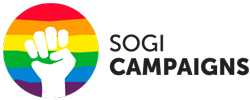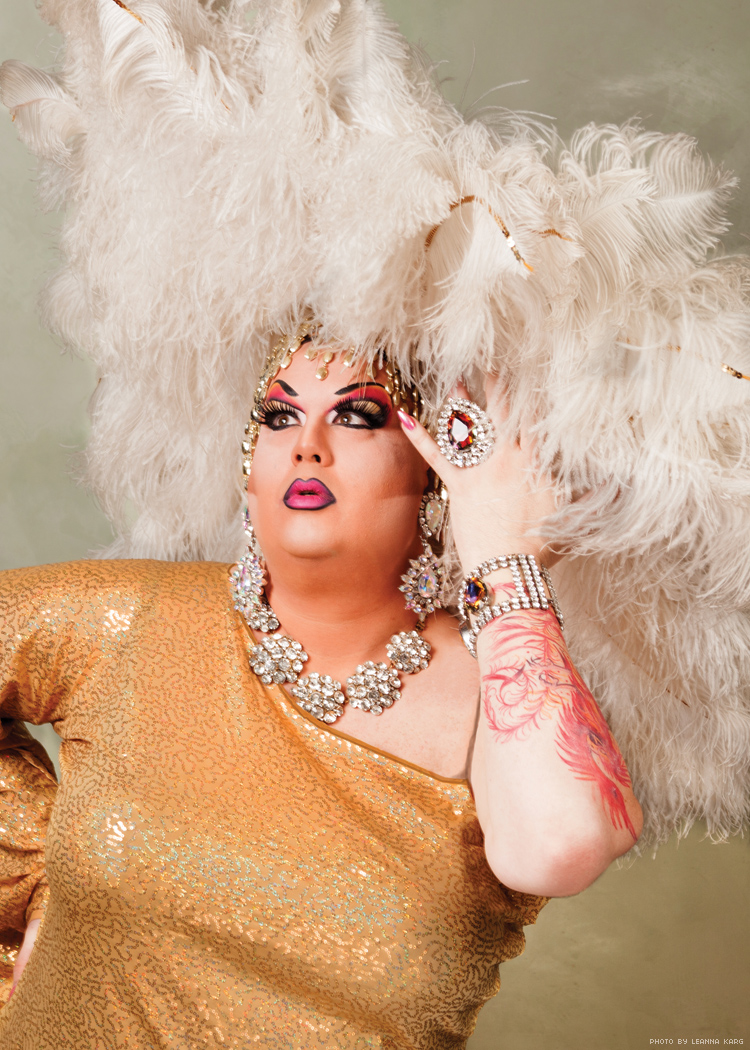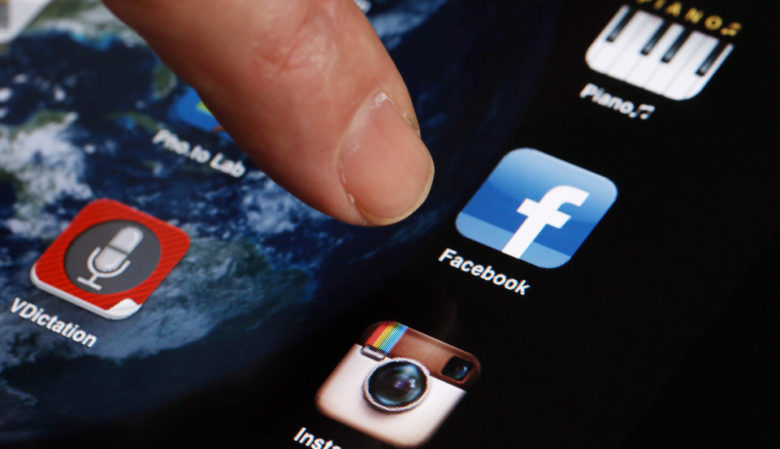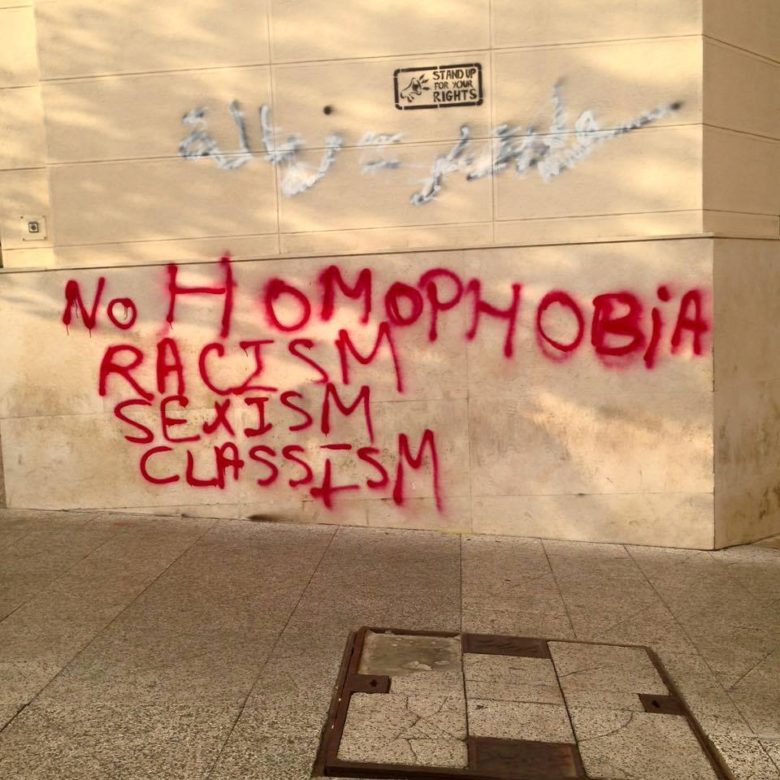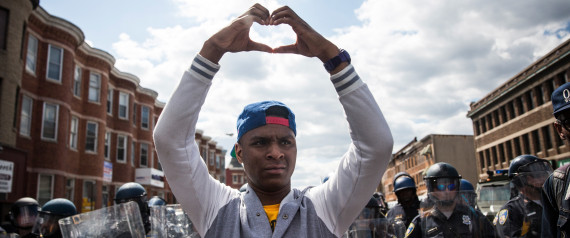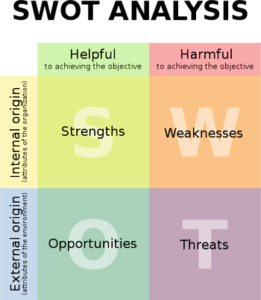The Power of Drag Activism
From The Advocate
In 1971, the day before the U.K. Gay Liberation Front planned to hold London’s first official Pride march, half a dozen radical drag activists took it upon themselves to run a dress rehearsal. It was a resounding success, one which saw them chased down Oxford Street by the metropolitan police. Over a decade earlier, drag queens in Los Angeles had fought back against overzealous cops arresting their friends at Cooper’s Donuts (1959). Those in San Francisco rioted against relentless police harassment at Gene Compton’s cafeteria (1966). And of course, New York queens hurled bricks, clashed with police, and made history at the Stonewall Inn (1969).
Drag queens have been fighting on the front line since the dawn of the modern LGBT rights movement. Even after these flashpoints in queer history, many continued to do so, using their prominent community status to champion equality.
Post Stonewall, Sylvia Rivera and Marsha P. Johnson formed Street Transvestite Action Revolutionaries (STAR) to fight for vulnerable LGBT groups, including homeless drag queens and queer runaways (including the transgender women they advocated for, though this was in an era that predates the language we now use for trans and gender-nonconforming people). Since their first performance on Castro Street in the late ’70s, the Sisters of Perpetual Indulgence have used drag, protest, and highly controversial religious imagery to raise over $1 million for various AIDS– and LGBT-related causes, educating people along the way. And many queens joined ACT UP during the AIDS epidemic, attending die-ins at Catholic churches and protesting against pharmaceutical companies that withheld HIV drugs.
History is (g)littered with queens who saw their roles as so much more than just performers. No queer fundraiser, protest, or riot is complete without at least one drag queen, it seems. But really it is no surprise that they’re so often at the heart of these movements; for many, the front line is seldom avoidable.
“We’re the ones walking out in the street in drag, so we’re the ones that people know are gay,” says Lady Bunny, herself no stranger to political engagement. “So if you’re a homophobic, drunk asshole out on the town to harass anyone, you might not know if the straight-acting gays are gay. But if you see a big drag queen or a very effeminate male homosexual, that’s going to be who gets the shit on the street — the people who were gay 24-7, not the straight-acting gay men who can pass for straight except for the one day a year they wear a rainbow outfit at Pride.”
The past few years have seen drag surge in popularity, inspired in part by greater acceptance of LGBT culture, as well as the more obvious global success of RuPaul’s Drag Race. When Miley Cyrus performed with Shangela, Laganja Estranja, Alyssa Edwards, and others at last August’s VMAs, it signaled to some that drag was now mainstream. Such sentiments may be
premature, but drag is definitely going through a golden era that a number of drag queens say hasn’t been seen since the 1990s.
Even as drag becomes more commercial, a host of queens continue to use their podiums and performances to challenge inequality and homophobia around the world.

Asifa Lahore
In the past two years, Ireland’s accidental activist and gender discombobulist Panti Bliss (a.k.a. Rory O’Neill) has been threatened with legal action, sparked a national debate about LGBT rights, seen a video of her speech on homophobia go viral (over 200,000 views in two days) then be remixed by the Pet Shop Boys, and become one of the figureheads for Ireland’s successful referendum on same-sex marriage. While she’s now viewed as one of the most prominent present-day LGBT activists, Panti sees it differently.
“What I see myself as is, well, just very determinedly being what I fucking want to be, and if in order to be that I need to get into the odd scrap, then yes — I’m just not the kind of person to shut up and stay quiet,” Panti says. “Most of the sort of things here that I’m particularly known for, from an activist point of view, is stuff that I’ve wandered into, and I’ve had to become an activist to get myself out of the situation. But I do think of myself as an entertainer first and an activist second.”
In early 2014, when O’Neill appeared out of drag on RTÉ’s The Saturday Night Show, he suggested that two Irish Times journalists, John Waters and Breda O’Brien, as well as the Iona Institute (a Catholic pressure group), were homophobic. And “Pantigate” was born. In the aftermath, O’Neill was accused of defamation (Ireland’s defamation laws are stricter than those in the U.S.), causing the Irish broadcaster to pull the episode from its online player, issue payouts to those mentioned, and have TV host Brendan O’Connor issue an on-air apology. Responding to the cause célèbre, Panti delivered her “Noble Call” at the Abbey Theatre in Dublin: an impassioned speech about oppression and homophobia, which saw everyone from RuPaul to Graham Norton praising her.
“When I made the speech that went viral, the night before I’d met with one of my lawyers — because at the time I had a team of lawyers — and one of my lawyers was a little uncomfortable with me doing it in drag,” says Panti. “His argument was, and I appreciate the argument, that people wouldn’t be able to see past the drag, or they’d be frightened off by the drag, or that it would somehow come between me and my message. But I was very determined to do it in drag, partly because it would have felt like a defeat if I hadn’t, because that is who I am and that is what this is all about.”
Had Panti listened to her lawyers and delivered her speech out of drag, it’s likely it wouldn’t have received anywhere near the attention it did. Drag didn’t addle her point, it amplified it.
“Just by the nature of what I do, my voice is louder than other people’s,” she says. “I think the activism enhances the entertainment. A good activist needs to be an entertainer in a way too, because people are more likely to listen to you if you’re way entertaining. They don’t need to be high-kicking and wearing funny outfits, but they need to have a stage presence in a sense, because that’s why people listen to you. And drag queens are used to that. Stagecraft helps.”

Mama Tits
As does social media. Drag queens have always been challenging the status quo, but nowadays when they do so they’ll likely be caught on film by a ubiquitous smartphone. At Seattle Pride in 2014, local queen Mama Tits (a.k.a Brian Peters) was videoed eloquently dismantling the logic of antigay Christian protesters who had turned up to picket the parade with homophobic signs and megaphones. A glorious and inspiring takedown, the video — aptly titled “Mama Tits is a Crusader!!” — has now been viewed over 1.8 million times.
Asifa Lahore, the U.K.’s most prominent Muslim drag queen, has achieved national fame over the past few years, with her story explored in documentaries by The Guardian and, more recently, the U.K.’s Channel 4. Since donning a rainbow burqa at a drag competition, she’s become a figurehead for what is known as Britain’s “gaysian” community. Asifa’s performances and activism challenge what it is to be gay and Muslim to such an extent that she’s been condemned by conservative mosques in Britain. To this day, she still receives detailed death threats.
“As soon as I started doing drag, I received death threats, and four years later things haven’t changed,” says Asifa (a.k.a. Asif Quraishi). “There was a time very early on in my career where I nearly gave up doing drag. A boy dressing up as a girl? Was it really worth all the heartache and pain it was causing me and my family? But I knew that if I gave in then I’d be making myself unhappy, so I carried on performing and will continue to perform. Every day I live the point is made. I exist, I matter, and I am alive.”
Asifa received a Pride award from Attitude magazine in June 2015 for her work empowering Britain’s LGBT Muslim community. It’s not been an easy journey. As a young man, Quraishi found his conservative Muslim upbringing conflicted greatly with his sexuality: his family tried to force him into an arranged marriage with a female cousin; when he eventually did come out, he was taken to a doctor; and when he told his imam, he was told to lead a life of celibacy. Quraishi’s activism is driven by his struggle of growing up gay in a hetero-dominant world, something many drag queens (and LGBT activists generally) can attest to.

Lady Bunny
“When you become a drag queen, you are put on the bottom — no pun intended — of the totem pole in terms of being thought of as a desirable man,” says Lady Bunny. “It can force us to develop a defiant ‘fuck the status quo’ attitude, because we aren’t going to stop doing drag just to fit in. This same defiance enables us to question the church, politicians, or anything else that stands in our way. Most of us are never going to be mainstream, so we don’t need to soft-pedal our opinions.
“Drag queens have the ability to look at themselves and see how they can change it. If you look in the mirror and see a huge jaw, you’re going to need a really tall wig to soften that mug! If you can change how you appear without makeup and drastically rearrange it, that manner of thinking can also enable some to make tough assessments of what society needs. Especially when society is attacking us. Don’t mess with someone whose nuts are shoved up their ass. We’re prone to snap.”
If the ability to change is the nature of drag, then defiance is its essence. Channeling the experiences of a tough and harrowing childhood through their drag gives many queens an edge as activists.
“If you’re on the front line your whole life…you really develop survival skills at an earlier age,” says Peaches Christ, who grew up in a Catholic household. “This comes from a place of growing up and being a sissy in a society that tells you not to, that says the way you’re gendering yourself is abnormal, you shouldn’t want to play with dolls, you shouldn’t be interested in makeup. You’re forced into a position of defending yourself and learning how to stand up for yourself at a very young age.”

Peaches Christ
In many ways, the performance of drag itself is activism. Whether it’s strutting down RuPaul’s runway in the couture or standing silently on a street corner donning a cheap skirt and wig, drag is an inherent rejection of societal norms and conservative views on gender and sexuality. And it still courts controversy.
When Peaches (a.k.a. Joshua Grannell) took her show Bearbarella to Northern Ireland, she was met by government officials who accused her of blasphemy and lewdness.
“It was a huge reminder that ‘Oh, right, I still stand for something,’” she says. “When we got a standing ovation in Northern Ireland, it wasn’t because my Bearbarella show was brilliant — it’s full of poppers and dildos and about a bear drag queen saving the universe — but it was because of what it stood for, which was, we’re going to do whatever the fuck we want and we’re going to be proud of this stupidity, grossness, and sexuality.”
Drag has always challenged gender conventions and societal norms since the days when cross-dressers in Victorian London like Thomas Boulton and Frederick Park were charged with conspiring to commit an unnatural offense. It wasn’t too long ago that female impersonation was illegal in parts of the United States. In some countries it still is. Ripping off a wig at the climax of a fierce lip-sync, choosing a provocative name, wearing a beard — drag still affords plenty of nuances that can be read as political statements.
“Certainly naming yourself after Jesus is an intentionally antagonistic thing — I was young and I was very angry and I was raised Catholic,” says Peaches. “Performing in drag in some ways is a political act, no matter where you are, and even though it’s more popular, the reality of it is, it’s still very transgressive. There is, unfortunately, in the U.S., such a thing as being too gay. And it really affects our access to other kinds of platforms and entertainments. So while RuPaul’s Drag Race is very popular, I would still argue that it’s cult and niche.”

Conchita Wurst
Whether the art itself is or isn’t mainstream, there are still many queens whose popularity transcends the queer community. Conchita Wurst became a global icon in 2014 when she won Eurovision, with her Shirley Bassey–esque voice and glamorous style. As a bearded drag queen she was always going to shock mainstream audiences, and it’s this — her particular brand of genderfuck drag — which transformed Wurst (the drag persona of Austrian singer Thomas Neuwirth) from exceptional per former to LGBT champion, voicing a backlash against queer persecution in Russia.
Without its shock factor, drag loses its potency. As a tool for political and social change it becomes blunted. “When it’s mainstream, it’s often defanged a lot,” says Panti. “It doesn’t allow room for the angry drag, the genderfuck drag, the punk elements of drag. I do always worry about that whenever drag is mainstreamed. It’s sanitizing drag in a way. It’s taking away the danger and the sex and the dirt. And I like the danger, the sex, and the dirt. That’s why I got into it in the first place.”
There are even factions within the LGBT community which struggle to accept drag. Earlier this year Glasgow Free Pride — an anti-commercialist alternative to the city’s main event — was roundly criticized by many prominent figures in the LGBT community after it banned drag queens from performing, for fear of upsetting the transgender community.
“As much as I obviously disagreed with Free Pride’s decision on so many levels, I did like that it showed you that drag still has the power to — I don’t want to say offend people, because that’s different — but to make people uneasy and to consider things that they don’t always like to consider,” says Panti.
Despite astounding progress since Cooper’s, Compton’s, and Stonewall, so many issues remain unresolved. But even in such a desensitized era, drag continues to shock the establishment, empower the marginalized, and challenge the norm. It’s transgressive and provocative, symbolic and subversive. In the fight for universal LGBT liberation, the role of drag queens and their art shouldn’t be underestimated.
“[Drag] is a statement in itself,” Panti continues. “And the statement says you’re all wrong — fuck you. It still has the power to discombobulate people, to upset people. And it should, because these issues, about gender and sexuality, are all unresolved.”
